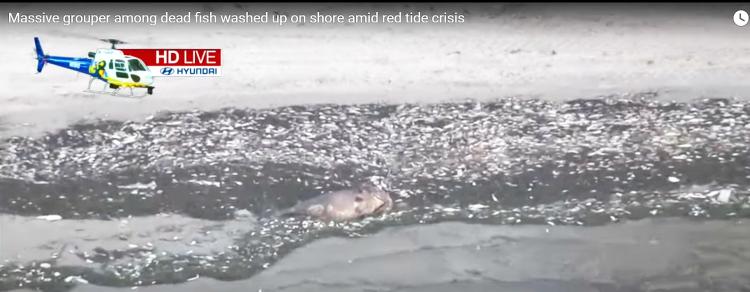 A recent editorial headline in the Tampa Bay Times read “In St. Petersburg, climate change smells like rotting fish” and was subtitled “A massive fish kill reminds us how climate change can suddenly wash up on our shores.”
A recent editorial headline in the Tampa Bay Times read “In St. Petersburg, climate change smells like rotting fish” and was subtitled “A massive fish kill reminds us how climate change can suddenly wash up on our shores.”
The latest round of red tide has returned to the waters of Florida’s Gulf Coast.
I went to high school in St. Petersburg, and still remember vividly the stench of the red tide. The toxic algae bloom covered the beaches and clogged the waterways with tons of dead fish and other sea life. Cleanup crews did their best to keep up with the rotting fish as they washed ashore, although, at times, the task seemed close to futile, akin to the proverbial shoveling sand against the tide.
In the first week of the current outbreak, close to 700 tons of dead sea life has been removed from beaches and waterways around Tampa Bay.
It is impossible to say how long the outbreak will last. Florida’s red tides can appear throughout the year, though they usually peak late summer to early fall and can last from a few days to months. The last bad outbreak in 2017–2018 lasted 16 months. The worst red tide on record lasted 30 months from 1994–1997.
While the Tampa Bay Times editorial headline is dramatic, red tide cannot be blamed solely on climate change or pollution, although it is likely that each makes the red tide outbreak worse. Red tide has probably always been present on the Florida Gulf Coast. The first scientifically documented red tide bloom in Florida dates back to 1844, predating extensive human development.
Florida red tide is caused by the blooming of the dinoflagellate Karenia brevis. K. brevis produces neurotoxins that can cause respiratory problems in humans and attack the central nervous systems of fish and other wildlife.
Red tide blooms originate naturally 10-40 miles offshore in the bottom waters of the Gulf of Mexico. K. brevis cells that hang out at the bottom are brought to the surface by a phenomenon known as upwelling, a process in which deep, cold and nutrient-rich water rises to the surface. Winds and ocean currents then bring the bloom inshore where it has an impact on the coasts. The current outbreak is thought to have been blown ashore by Tropical Storm Elsa.
From the Sea Grant Florida – Understanding Florida’s Red Tide: Once the bloom moves nearshore, nutrients associated with decaying red tide and fish kill biomass are among the most significant nutrient sources for blooms. So much so, that red tide has been considered nearly self-sustaining. Nearshore red tide blooms can also obtain nutrients from air pollution, releases from rivers and estuaries, and estuarine flux, or the exchange of nutrients to and from the estuary.
When the bloom makes its way inshore, it feeds on excess nitrogen and phosphorus coming from various nutrient sources along the coast including stormwater runoff, fertilizer runoff, septic tanks, and/or faulty wastewater systems.
St. Pete leaders beg for state help with overwhelming red tide cleanup

Good job providing balance and perspective –the real facts behind the overly simplistic headlines! Your articles are always very informative!